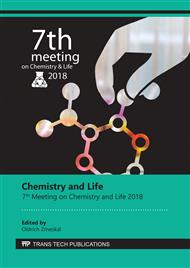p.44
p.50
p.56
p.62
p.68
p.74
p.80
p.86
p.92
The Effect of Final Heating on the Concentration of Phthalic Acid Esters by Sous-Vide Production
Abstract:
In our research the influence of thermal heating on the release of plasticizers from plastics into the meat product and water was researched. The two most widely used plasticizers, dibutyl phthalate (DBP) and di-(2-ethylhexyl) phthalate (DEHP), were detected. Both of the plasticizers have a negative effect on the health. And both are regulated by regulation of the European Union. In this study were researched phthalates in products prepared by sous-vide technology and it was studied effect of reheating on migration of phthalates. The average concentrations of both phthalate esters, DBP and DEHP, in heated water decreased. The average concentration of DBP in water before heating was detected 0.82 mg/100 ml and after heating 0.52 mg/100 ml, the average concentration of DEHP in water before heating was established 0.33 mg/100 ml and after heating 0.19 mg/100 ml. In plastic wraps, average DBP concentration with reheating increased and average DEHP concentration with reheating dropped. The average DBP concentration in plastic packaging, heating at 60 °C/12 h was determined of 9.87 mg/dm2 after reheating 60 °C/1 h was detected of 15.40 mg/dm2. The average concentration of DEHP in plastic packaging, heating at 60 °C/12 h was determined of 58.71 mg/dm2 and after reheating 60 °C/1 h was detected of 28.28 mg/dm2. The average DBP concentration in meat products due to reheating decreased, the average DEHP concentration in meat products increased. The average DBP concentration in meat products heating at 60 °C/12 h was detected of 8.39 mg/g dry matter and after reheating of 6.43 mg/g dry matter, the average DEHP concentration heating at 60 °C/12 h was determined of 25.37 mg/g dry matter and after reheating of 65.51 mg/g dry matter..
Info:
Periodical:
Pages:
80-85
Citation:
Online since:
May 2019
Authors:
Keywords:
Price:
Сopyright:
© 2019 Trans Tech Publications Ltd. All Rights Reserved
Share:
Citation:


